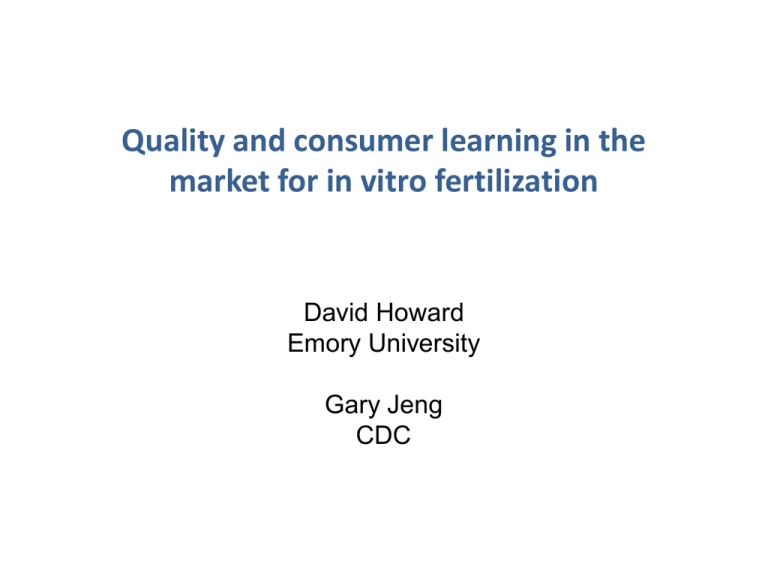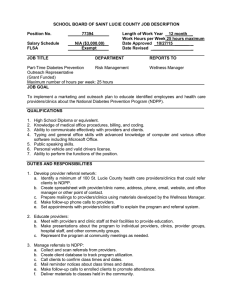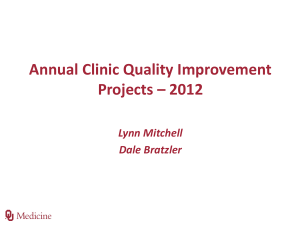Quality and consumer learning in the market for in vitro fertilization
advertisement

Quality and consumer learning in the market for in vitro fertilization David Howard Emory University Gary Jeng CDC Are patients good consumers? In most commodities, the possibility of learning from one’s own experience or that of others is strong because there is an adequate number of trials. In the case of severe illness, that is, in general, not true; the uncertainty due to inexperience is added to the intrinsic difficulty of prediction. -Kenneth Arrow 1965 Strategy Do experienced patients switch to better clinics? If yes, then patients are learning through experience If experience is a source of learning, then first time patients are not fully informed The sample Nearly 100% sample of the women who received their first IVF cycle in 2004-2005 85,718 patients 40,321 has more than one cycle 4,732 switched clinics Overview of analyses A. Describe switching patterns B. Estimate determinants of switching C. Estimate choice model A. Switching patterns Cycle By total cycles Patients Switchers % By cycle at switch Cycles Switches % 2 3 4 5+ 22,135 10,559 4,548 3,079 1,370 1,508 987 867 0.06 0.14 0.22 0.28 40,376 18,350 7,824 5,572 2,230 1,574 715 519 0.06 0.09 0.09 0.09 Total 40,321 4,732 0.12 72,122 5,038 0.07 A. Switching patterns Cycle By total cycles Patients Switchers % By cycle at switch Cycles Switches % 2 3 4 5+ 22,135 10,559 4,548 3,079 1,370 1,508 987 867 0.06 0.14 0.22 0.28 40,376 18,350 7,824 5,572 2,230 1,574 715 519 0.06 0.09 0.09 0.09 Total 40,321 4,732 0.12 72,122 5,038 0.07 B. Determinants of switching Pr(switch) = f(attributes of the previous clinic, patient characteristics) B. Determinants of switching Pr(switch) = f(attributes of the previous clinic, patient characteristics) 1. Patients treated at clinics with lower quality are slightly more likely to switch B. Determinants of switching Pr(switch) = f(attributes of the previous clinic, patient characteristics) 1. Patients treated at clinics with lower quality are slightly more likely to switch 2. Patients whose previous IVF cycle resulted in pregnancy w/ miscarriage (versus no pregnancy) are less likely to switch. B. Determinants of switching Pr(switch) = f(attributes of the previous clinic, patient characteristics) 1. Patients treated at clinics with lower quality are slightly more likely to switch 2. Patients whose previous IVF cycle resulted in pregnancy w/ miscarriage (versus no pregnancy) are less likely to switch. -bad experiences prompt search C. Mixed multinomial logit model Pr(patient i chooses clinic j) = f(clinic attributes, patient characteristics) Chose sets constructed based on a 150 mile radius around patients’ homes, limited to a maximum of 20 clinics One observation for each clinic-patient pair Estimates obtained via simulated maximum likelihood Results from the choice model If a clinic increased its success rate by one standard deviation, how much would demand increase: 25%, among first-time patients 27%, among experienced patients Conclusions Imagine the market for IVF was comprised entirely of experienced patients. Would clinics face a stronger incentive to improve quality? Conclusions Imagine the market for IVF was comprised entirely of experienced patients. Would clinics face a stronger incentive to improve quality? No. Demand among experienced patients is only slightly more responsive to quality than demand among first-time patients. Most clinics would probably not perceive a difference. Conclusions We observe some evidence of learning: 12% of patients switch. Why don’t more patients switch: 1.First time patients are well-informed. 2.Switching costs limit the ability of experienced patients to act upon their superior knowledge.



